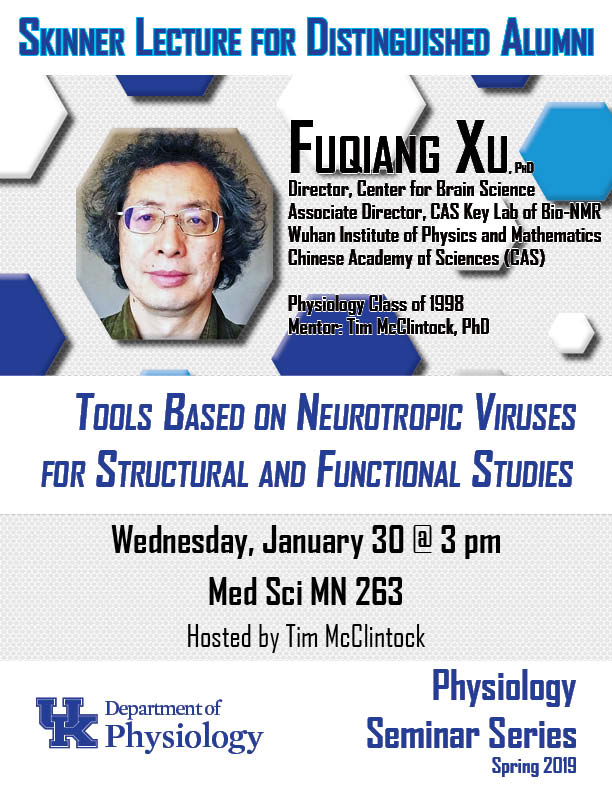Skinner Lecture Features Class of '98 Alum
Skinner Lecture for Distinguished Alumni, Physiology Seminar Series
"Tools Based on Neurotropic Viruses for Structural and Functional Studies"
Fuqiang Xu, PhD
Director, Center for Brain Science
Associate Director, CAS Key Lab of Bio-NMR Wuhan Institute of Physics and Mathematics Chinese Academy of Sciences (CAS)
Physiology Class of 1998
Mentor: Tim McClintock, PhD
Medical Science, MN 263 at 3pm
Wednesday, January 30, 2019
Each year the Department of Physiology invites a graduate who has been outstanding in their field to speak in the annual Skinner Lecture for Distinguished Alumni. This year, that honor goes to Fuqiang Xu, PhD.
Dr. Xu recieved his PhD from the Department of Physiology in 1998, under the mentorship of Dr. Tim McClintock. He has since achieved significant success and is currently at the Chinese Academy of Sciences in Shanghai.
Personal Biography:
"Professor XU Fuqiang, born in April, 1962, associate director of the CAS Key Lab of Bio-NMR. He obtained his BS and MS in chemistry from Lanzhou University; PhDs in chemistry (1994) and physiology (1998) from the University of Kentucky; received his postdoctoral training in the Departments of Neurobiology, Molecular Biophysics and Biochemistry, Yale University (1998-2001); took a Research Faculty position in the Magnetic Resonance Research Center, Yale University (2002-07), and Professor of Neurobiology, Neuroscience, and Neuroimag in Wuhan Institute of Physics and Mathematics, CAS since 2007. The honors he has won including "the Outstanding Young Scientist" from NSFC (2007). He has served as the member of Standing Board for the Chinese Society of Neuroscience (2015), Associated Chair of the Committee for Neuroscience Technology (2009), Secretary of the North American Associate of Neuroscience, member of Strategic Plan for Neuroscience in 13-5 (NSFC, 2014). His research has been supported by grants from various funding agencies, including the Strategic Frontier Plan B of CAS (2012),Key grant from NSFC (2011),973 Project from MST (2014, as group leader) and 3551 grant from High Technology (2014)."
Research:
1. Development of virus-based tools to reveal the structure and function of neurocircuit
Almost infinite number of neurocircuits is the basis of all brain functions. However, lacking of efficient tools leads to our very limited understanding of the structures and the corresponding functions of these circuits. In the past 10 years, by combining current advances in the related fields, such as neurobiology, molecular & cellular biology, virology, neuroimaging and bioengineering, the laboratory has been focused on developing virus-based tools that are of low toxic, high sensitivity, flexible, simple, cell specific, spread direction and range controllable labeling of neurocircuit in various types of species. Several hundreds of related tracers have been commercialized, along with the corresponding platforms, having been supporting the researches in the neuroscience and related fields nationally and internationally.
2. Olfactory system and its relationship with brain diseases
As arguably the earliest and innermost sensory system, olfactory system has close relationship with various brain diseases. However, the structure and the functional mechanisms of the system themselves are poorly understood. Based on the researches in the past 20 years in the olfactory system, the lab has been integrating proteomics, molecular biology, optical and magnetic resonance imaging, electrophysiology, circuit-tracing and dissecting, optogenetics, MRS, NMR and behaviors to reveal the basic structure of the related neurocircuits, the mechanisms of information coding, processing, learning and memorizing, and the abnormalities on different levels in related brain diseases during the progressive development.
He has published over 90 papers, including Science, Nature Neuroscience (2), Neuron (3), Trends in Neuroscience, Nature Communications (4), PNAS (3), Current Biology, Cell Reports, eLife, Journal of Neuroscience (5), Neuroimage (3), and over 20 patents. The research has been supported by grants from various funding agencies, including the Strategic Frontier Plan B of the CAS (2012-2022) and Breakthrough Grant (2012); Key grants (2011, 2019), Integration grant (2016), International Collaboration grant (2017), and R01s (2011, 2017) from the NSF of China; 973 Project from MST (2014, group leader); and "3551" grant from High Technology (2014).
